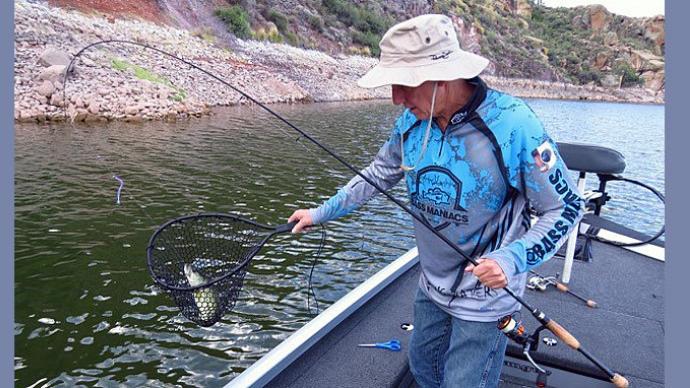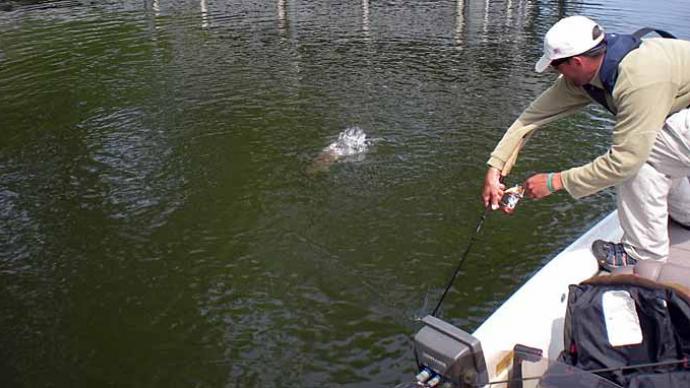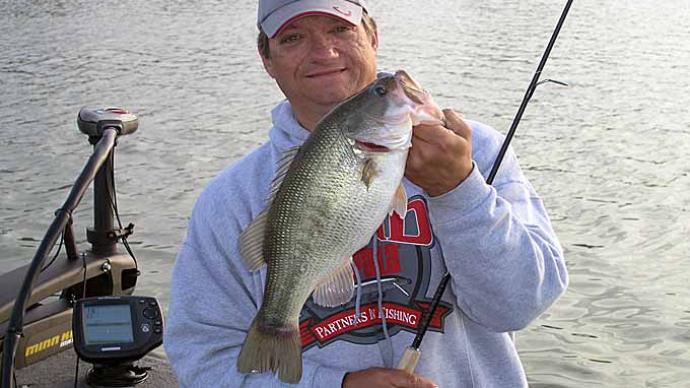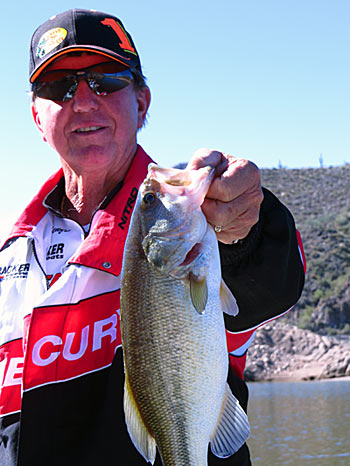
The split shot rig is certainly nothing new – by most accounts, it was dreamt up by a fisherman named Dick Trask in California in the mid-’70s. It’s an old technique, but it still works today – and maybe even better because many anglers have abandoned the split shot rig in favor of newer techniques like the drop shot, the Neko rig, and the Ned rig. Although many think of split-shotting as a primarily deep-water tactic, you can catch a lot of fish on almost any lake fishing a split shot relatively quickly in shallow water. Since it also excels in deep, clear water, the split shot rig will catch fish in just about any condition. Gary Dobyns is pretty happy that split-shotting has fallen out of favor – he says it’s easy to rig and highly productive. Gary says the trouble with fishermen is that when something new comes out, we jump on it, have success, and leave the old ways behind. But that certainly doesn’t mean they don’t work anymore.
The Rig
The basic split shot rig is simply a finesse hook with a split shot crimped about eighteen inches up the line. You can use just about any finesse hook you like best – a curled one, straight, offset – whatever. Just make sure it’s solid and sharp. I usually use a 1 or 1/0 offset finesse hook to Texas rig the worm, but I’ve also used a round drop shot hook if I’m in reasonably open water and can leave the hook exposed. The eighteen-inch leader is an excellent place to start, and you can shorten it a bit if the bite is good and lengthen it if it’s tough. The rule of thumb is twelve inches for shallow water (15 feet or less) and eighteen inches for deeper water. You may need to go to a three-foot leader if the fish are suspended.
A round split shot with no ears is best because the ears can cause it to spin, and you’ll get a lot of twists in your line—no Bueno. Use the lightest shot you can get away with and still be able to tell where it is. Keep the line light – six- to eight-pound-test fluorocarbon or mono works best.
If you’re worried about the line getting damaged by the shot pinched on it, many guys use a small cylinder weight and peg it with a rubber nail. Besides not damaging your line, this advantage is that you can quickly move the weight and change the length of the leader. The downside is that getting snagged on rocks or branches can push your weight down to the hook, but that can also happen with a pinched-on shot.
I’ve also experimented with light braided line, but you almost have to use a swivel, or the shot won’t stay put. If you do that, you can use fluorocarbon or mono for the leader, but it’s a lot more effort to change the leader length with that setup. One thing you need to remember, no matter how you rig it, is to check your line often. Light line can get damaged easily, and you don’t want to break off on a good fish.
A good split shot rod is a spinning rod with a good backbone but some bend in the tip. A medium-light fast action 7-foot graphite rod is ideal. My split-shot rod is a Dobyns DRX722SF. It was pricey, but it can be used for different techniques. Check the base near the handle to see the lure weights, and line the rod is recommended. Sometimes they even specifically state the technique the rod is designed for. You want to be able to set the hook, but you don’t want to rip it out of the fish’s mouth. Your reel should be large and fast so that you can take up a lot of line in a hurry – split-shotting often involves having a lot of line out.
The Technique
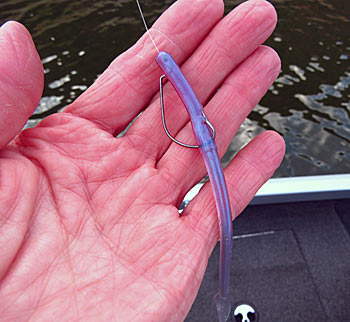
This is relatively simple to fish, but you need the practice to get a feel for it. Keeping contact with the bottom is essential, but you still need the line to be fairly taut so that you can feel the bites. On days when the water is glass, and the fish have lockjaw, you need to use a very slow retrieve. You may only be moving the lure three inches at a time. Once you locate fish, cast past them and keep the spool open until the lure hits bottom. You can tell this has happened when the line goes slack. Once that happens, take up the line slowly until it is taut, then start moving the lure just a bit at a time, using the rod, and keeping the line taut. When you reach a rock or a stump, you’ll be able to feel the weight climb up it. Crawl the bait over by using the rod to lift it, and when it starts to fall, follow it down with the rod so it can fall straight down and not pendulum away from the structure.
You can move the split shot rig with the boat if there is a nice breeze, falling barometric pressure, and active fish. If I drop the lure to the bottom instead of casting, I get hung up much less. Once it hits bottom, drag it slowly and use the boat's movement and your rod to lift and drop the weight as needed. This is my go-to technique when fishing from the back of the boat. When the weight moves forward, the bait rises and darts forward with it, and then it begins to drift toward the bottom while the weight is still. It’s more action than a drop-shot rig and highly effective whether you’re fishing fast or slow. If the bite is tough, use a small bait like a reaper. A better bite still calls for a finesse worm (you don’t want to overpower your weight), but you can go to a six-inch worm if they’ll take it. I’ve also had enormous success using floating baits on a split-shot rig.
I was out with Nitro Pro and Arizona boy Gary Senft one summer, and he taught me yet another way to fish a split-shot rig. It was one of those blistering hot Arizona summer days, and we were on Bartlett lake with a ridiculous amount of boat traffic and fishing pressure, but Gary was catching them a lot shallower than I thought they’d be. Gary was dragging a split-shot rig down a point, focused on fishing when he discovered that the fish were picking the bait up and staying still. When the rig would move, the split-shot would come up off the bottom and not go back down. It was just swinging there. He tugged the line just a little, and suddenly the fish turned and ran for it.
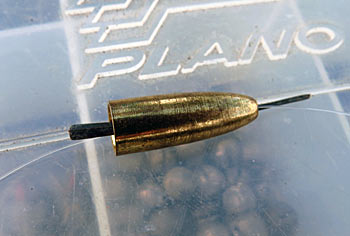
Gary dragged that split-shot rig around one inch at a time, weighing the feel of the rig on every move. There was no tug, no pressure, no nothing. He had to keep feeling for the rig to become weightless. Later in the day, he shortened his leader to about eight inches and started pitching the rig to shade and catching them in less than two feet of water. Senft loves the split shot and will adapt it to various presentations: shorter leader for pitching, a cylinder weight for weeds or brush, and a harder metal for riprap.
The bite can be so subtle that if you’re hanging on to the rod tightly, you’ll miss it. A guy named Gregg Warne was the one who first introduced me to split shotting, and he told me to hold the rod very loosely, with my hand almost open and the rod tip pointing toward the bait. Give the rod a little room to swing. If a fish feels resistance too quickly, he’s likely to spit it out before you can set the hook.
Hookset
A sweeping hookset gives you two entire rod lengths to take up the slack line and get that hook into the fish. If you’ve kept your line taut, once you feel or see a bite, sweep that rod out to the side and behind you as fast and as hard as possible. You may have a lot of line out, and you need to get the hook into him, so reel the whole time. Once you’ve got the hook in him, keep the pressure on and try not to switch the rod from side to side, giving the line slack. Keep him coming, and don’t give that hook a chance to fall out or work loose. Swinging a split-shot fish over the side is possible, but only if you use strong hooks. If your hook has give or it may straighten out, don’t risk it – get the net or lip him in the water.
Final Thoughts
When the bite is tough, people often get anxious and start fishing faster without meaning to. This is not what you want to do. The more challenging the bite, the slower you should move the bait. However, the opposite is also true. If the fish are smacking it, you can step it up a bit, but go back down if you start getting fewer bites. There is no right or wrong place or time to use a split shot. That being said, it does excel in clear, deep water. You can fish it through grass, but it will gather a lot of muck, even if you use a pointed or cylinder weight. But doing that with a floating worm is killer in summer. If you want to master split shotting, go out and start doing it. It’s pretty easy. You’ll like it.
BassResource may receive a portion of revenues if you make a purchase using a link above.


